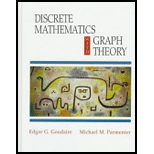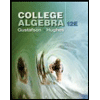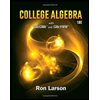
Discrete Mathematics with Graph Theory (Classic Version) (3rd Edition) (Pearson Modern Classics for Advanced Mathematics Series)
3rd Edition
ISBN: 9780134689555
Author: Edgar Goodaire, Michael Parmenter
Publisher: PEARSON
expand_more
expand_more
format_list_bulleted
Textbook Question
Chapter 10.1, Problem 9TFQ
A sub graph of a connected graph must be connected.
Expert Solution & Answer
Want to see the full answer?
Check out a sample textbook solution
Chapter 10 Solutions
Discrete Mathematics with Graph Theory (Classic Version) (3rd Edition) (Pearson Modern Classics for Advanced Mathematics Series)
Ch. 10.1 - Prob. 1TFQCh. 10.1 - A path is a walk in which all vertices are...Ch. 10.1 - 3. A trail is a path
Ch. 10.1 - A path is trail.Ch. 10.1 - A cycle is a special type of circuit.Ch. 10.1 - 6. A cycle is a circuit with no repeated edges
Ch. 10.1 - 7. An Eulerian circuit is a cycle.
Ch. 10.1 - Prob. 8TFQCh. 10.1 - A sub graph of a connected graph must be...Ch. 10.1 - Prob. 10TFQ
Ch. 10.1 - K8,10 is Eulerian.Ch. 10.1 - Prob. 12TFQCh. 10.1 - 13. A graph with more than one component cannot be...Ch. 10.1 - Prob. 1ECh. 10.1 - [BB] Answer the Konigsberg bridge Problem and...Ch. 10.1 - Prob. 3ECh. 10.1 - Prob. 4ECh. 10.1 - Prob. 5ECh. 10.1 - 6. Suppose we modify the definition of Eulerian...Ch. 10.1 - 7. (a) Is there an Eulerian trail from A to B in...Ch. 10.1 - [BB] (Fictitious) A recently discovered map of the...Ch. 10.1 - 9. Euler’s original article about the Konigsberg...Ch. 10.1 - Prob. 10ECh. 10.1 - Prob. 11ECh. 10.1 - [BB] For which values of n1 , if any, is Kn...Ch. 10.1 - 13. (a) Find a necessary and sufficient condition...Ch. 10.1 - Prob. 14ECh. 10.1 - 15.[BB] Prove that any circuit in the graph must...Ch. 10.1 - Prob. 16ECh. 10.1 - Prob. 17ECh. 10.1 - Prob. 18ECh. 10.1 - Prob. 19ECh. 10.1 - Prob. 20ECh. 10.1 - Prob. 21ECh. 10.1 - Prob. 22ECh. 10.1 - Prob. 23ECh. 10.1 - Prob. 24ECh. 10.1 - 25. Prove that a graph is bipartite if and only if...Ch. 10.1 - Prob. 26ECh. 10.1 - Prob. 27ECh. 10.2 - A Hamiltonian cycle is a circuit.
Ch. 10.2 - Prob. 2TFQCh. 10.2 - Prob. 3TFQCh. 10.2 - Prob. 4TFQCh. 10.2 - Prob. 5TFQCh. 10.2 - A graph that contains a proper cycle cannot be...Ch. 10.2 - Prob. 7TFQCh. 10.2 - Prob. 8TFQCh. 10.2 - Prob. 9TFQCh. 10.2 - Prob. 10TFQCh. 10.2 - Prob. 1ECh. 10.2 - 2. Determine whether or not each of the graphs of...Ch. 10.2 - Determine whether each of the graph shown is...Ch. 10.2 - Prob. 4ECh. 10.2 - Consider the graph shown. Is it Hamiltonian? Is...Ch. 10.2 - Prob. 6ECh. 10.2 - Prob. 7ECh. 10.2 - Does the graph have a Hamiltonian cycle that...Ch. 10.2 - Prob. 9ECh. 10.2 - Prob. 10ECh. 10.2 - How many edges must a Hamiltonian cycle is kn...Ch. 10.2 - 12. Draw a picture of a cube, by imagining that...Ch. 10.2 - Prob. 13ECh. 10.2 - Prob. 14ECh. 10.2 - Prob. 15ECh. 10.2 - Prob. 16ECh. 10.2 - Suppose G is a graph with n3 vertices and at least...Ch. 10.2 - 18.[BB] Suppose G is a graph with vertices such...Ch. 10.2 - Prob. 19ECh. 10.2 - Prob. 20ECh. 10.2 - Answer true of false and in each case either given...Ch. 10.2 - Prob. 22ECh. 10.2 - Prob. 23ECh. 10.2 - Find a necessary and sufficient condition on m and...Ch. 10.3 - Prob. 1TFQCh. 10.3 - Prob. 2TFQCh. 10.3 - Prob. 3TFQCh. 10.3 - Prob. 4TFQCh. 10.3 - Prob. 5TFQCh. 10.3 - Prob. 6TFQCh. 10.3 - Prob. 7TFQCh. 10.3 - Prob. 8TFQCh. 10.3 - Prob. 9TFQCh. 10.3 - Prob. 10TFQCh. 10.3 - Prob. 1ECh. 10.3 - Prob. 2ECh. 10.3 - Prob. 3ECh. 10.3 - Prob. 4ECh. 10.3 - Prob. 5ECh. 10.3 - Prob. 6ECh. 10.3 - Prob. 7ECh. 10.3 - 8. (a) [BB] Find the adjacency matrices and of...Ch. 10.3 - 9. Repeat Exercise 8 for the graphs and shown....Ch. 10.3 - Prob. 10ECh. 10.3 - Let A=[abcpqrxyz] and let P=[010001100]. Thus P is...Ch. 10.3 - Prob. 12ECh. 10.3 - 13. For each pair of matrices shown, decide...Ch. 10.3 - 14. [BB] Let A be the adjacency matrix of a...Ch. 10.3 - Prob. 15ECh. 10.3 - Prob. 16ECh. 10.3 - Prob. 17ECh. 10.3 - Prob. 18ECh. 10.4 - Prob. 1TFQCh. 10.4 - Prob. 2TFQCh. 10.4 - It is an open question as to whether there exists...Ch. 10.4 - Prob. 4TFQCh. 10.4 - Prob. 5TFQCh. 10.4 - Prob. 6TFQCh. 10.4 - Prob. 7TFQCh. 10.4 - Prob. 8TFQCh. 10.4 - Prob. 9TFQCh. 10.4 - Prob. 10TFQCh. 10.4 - Prob. 1ECh. 10.4 - Prob. 2ECh. 10.4 - Prob. 3ECh. 10.4 - Prob. 4ECh. 10.4 - Prob. 5ECh. 10.4 - Prob. 6ECh. 10.4 - Prob. 7ECh. 10.4 - Prob. 8ECh. 10.4 - Prob. 9ECh. 10.4 - Prob. 10ECh. 10.4 - Prob. 11ECh. 10.4 - 12. [BB] Could Dijkstra’s algorithm (original...Ch. 10.4 - Prob. 13ECh. 10.4 - 14. (a) If weights were assigned to the edges of...Ch. 10.4 - Prob. 15ECh. 10.4 - Prob. 16ECh. 10.4 - Prob. 17ECh. 10.4 - Prob. 18ECh. 10.4 - Prob. 19ECh. 10.4 - Prob. 20ECh. 10.4 - Prob. 21ECh. 10.4 - Prob. 22ECh. 10.4 - Prob. 23ECh. 10.4 - Prob. 24ECh. 10 - In the Konigsberg Bringe Problem (see fig. 9.1),...Ch. 10 - Prob. 2RECh. 10 - Suppose G1 and G2 are graphs with no vertices in...Ch. 10 - Prob. 4RECh. 10 - Prob. 5RECh. 10 - Is the graph Hamiltonian? Is it Eulerian? Explain...Ch. 10 - Determine, with reason, whether each of the...Ch. 10 - Prob. 8RECh. 10 - Prob. 9RECh. 10 - Prob. 10RECh. 10 - Prob. 11RECh. 10 - Prob. 12RECh. 10 - Prob. 13RECh. 10 - Prob. 14RECh. 10 - 15. A connected graph G has 10 vertices and 41...Ch. 10 - Prob. 16RECh. 10 - Let v1,v2,........v8 and w1,w2,..........w12 be...Ch. 10 - Prob. 18RECh. 10 - Martha claims that a graph with adjacency...Ch. 10 - Prob. 20RECh. 10 - Which of the following three matrices (if any) is...Ch. 10 - Apply the first form of Dijkstras algorithm to the...Ch. 10 - Prob. 23RECh. 10 - 24. Apply the original form of Dijkstra’s...Ch. 10 - Apply the improved version of Dijkstras algorithm...Ch. 10 - Prob. 26RECh. 10 - 27. Apply the Floyd- Warshall algorithm apply to...Ch. 10 - Prob. 28RE
Knowledge Booster
Learn more about
Need a deep-dive on the concept behind this application? Look no further. Learn more about this topic, subject and related others by exploring similar questions and additional content below.Similar questions
Recommended textbooks for you
 College Algebra (MindTap Course List)AlgebraISBN:9781305652231Author:R. David Gustafson, Jeff HughesPublisher:Cengage Learning
College Algebra (MindTap Course List)AlgebraISBN:9781305652231Author:R. David Gustafson, Jeff HughesPublisher:Cengage Learning
 Trigonometry (MindTap Course List)TrigonometryISBN:9781337278461Author:Ron LarsonPublisher:Cengage Learning
Trigonometry (MindTap Course List)TrigonometryISBN:9781337278461Author:Ron LarsonPublisher:Cengage Learning- Algebra & Trigonometry with Analytic GeometryAlgebraISBN:9781133382119Author:SwokowskiPublisher:Cengage

College Algebra (MindTap Course List)
Algebra
ISBN:9781305652231
Author:R. David Gustafson, Jeff Hughes
Publisher:Cengage Learning


Trigonometry (MindTap Course List)
Trigonometry
ISBN:9781337278461
Author:Ron Larson
Publisher:Cengage Learning

Algebra & Trigonometry with Analytic Geometry
Algebra
ISBN:9781133382119
Author:Swokowski
Publisher:Cengage
Graph Theory: Euler Paths and Euler Circuits; Author: Mathispower4u;https://www.youtube.com/watch?v=5M-m62qTR-s;License: Standard YouTube License, CC-BY
WALK,TRIAL,CIRCUIT,PATH,CYCLE IN GRAPH THEORY; Author: DIVVELA SRINIVASA RAO;https://www.youtube.com/watch?v=iYVltZtnAik;License: Standard YouTube License, CC-BY